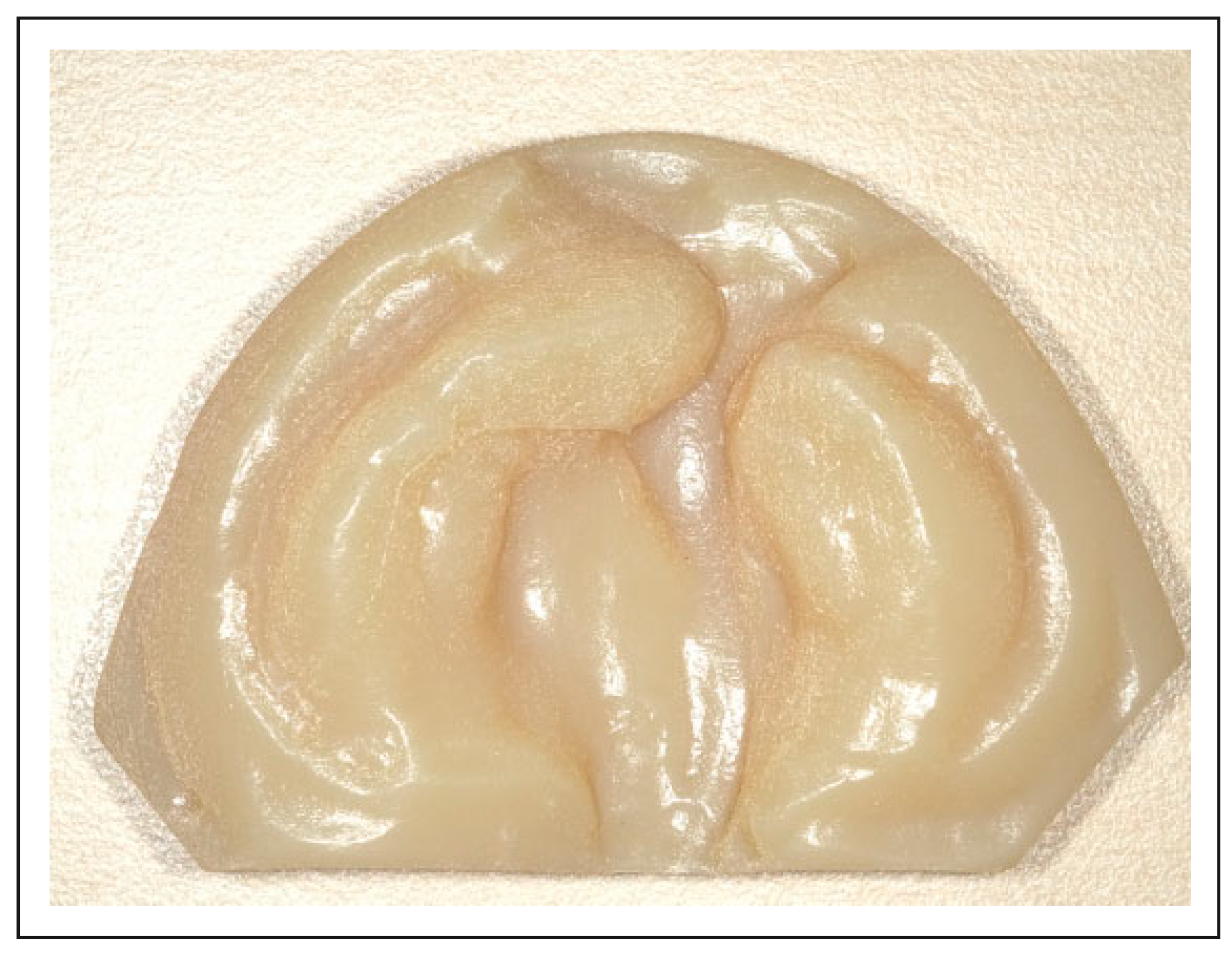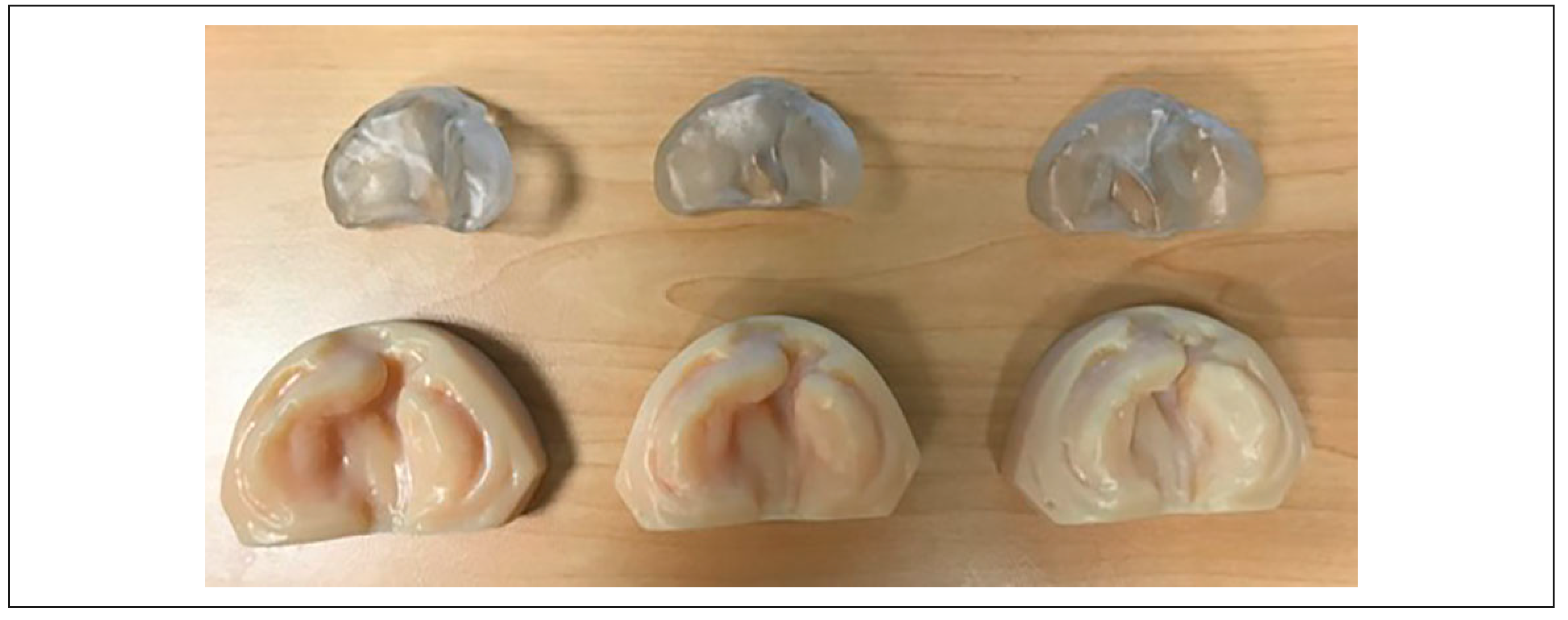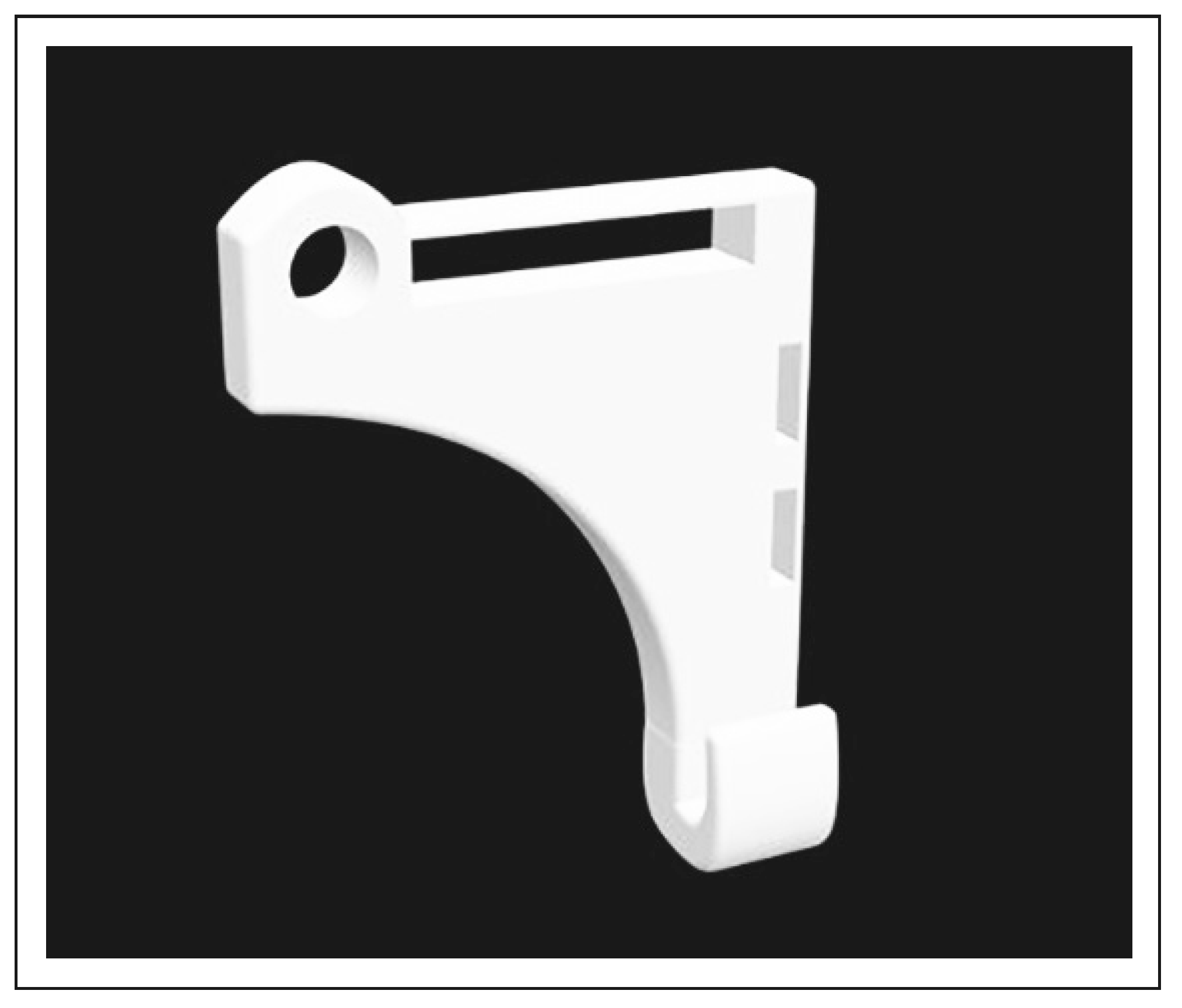Recent Advances in Nasoalveolar Molding Therapy Using 3D Technology
Abstract
:1. Introduction
2. Traditional Presurgical Nasoalveolar Molding (NAM) Therapy
3. Appliance Modifications to the Grayson NAM Technique
4. NAM Treatment Modifications for Unilateral Cleft Lip and/or Palate Patients
5. NAM Treatment Modifications for Bilateral Cleft Lip and/or Palate
6. Complications Associated with NAM Treatment Modifications
7. The Application of 3D Technologies to NAM Therapy
8. Application of 3D Printing to NAM Therapy
9. Applications of 3D Stereophotogrammetry in NAM Therapy
10. Conclusions
Funding
Conflicts of Interest
References
- Mossey, P.A.; Modell, B. Epidemiology of oral clefts 2012: An international perspective. Front Oral Biol. 2012, 16, 1–18. [Google Scholar] [CrossRef] [PubMed]
- Ahmed, M.K.; Bui, A.H.; Taioli, E. Epidemiology of Cleft Lip and Palate. Des. Strateg. Cleft Lip Palate Care 2017, 3–22. [Google Scholar] [CrossRef]
- World Health Organization. Addressing the Global Challenges of Craniofacial Anomalies Report of a WHO Meeting on International Collaborative Research on Craniofacial Anomalies; WHO: Geneva, Switzerland, 2006. [Google Scholar]
- Leslie, E.J.; Marazita, M.L. Genetics of cleft lip and cleft palate. Am. J. Med. Genet. C Semin. Med. Genet. 2013, 163, 246–258. [Google Scholar] [CrossRef]
- Wilson-Nagrani, C.; Richmond, S.; Paternoster, L. Nonsyndromic cleft lip and palate polymorphisms affect normal lip morphology. Front. Genet. 2018, 9, 413. [Google Scholar] [CrossRef]
- Dixon, M.J.; Marazita, M.L.; Beaty, T.H.; Murray, J.C. Cleft lip and palate: Understanding genetic and environmental influences. Nat. Rev. Genet. 2011, 12, 167–178. [Google Scholar] [CrossRef]
- Marazita, M.L.; Lidral, A.C.; Murray, J.C.; et al. Genome scan, finemapping, and candidate gene analysis of non-syndromic cleft lip with or without cleft palate reveals phenotype-specific differences in linkage and association results. Hum. Hered. 2009, 68, 151–170. [Google Scholar] [CrossRef]
- Birnbaum, S.L.K.; Reutter, H.; Herms, S.; et al. Key susceptibility locus for nonsyndromic cleft lip with or without cleft palate on chromosome 8q24. Nat. Genet. 2009, 41, 473–477. [Google Scholar] [PubMed]
- Mangold, E.; Ludwig, K.U.; Birnbaum, S.; et al. Genome-wide association study identifies two susceptibility loci for nonsyndromic cleft lip with or without cleft palate. Nat. Genet. 2010, 42, 24–26. [Google Scholar]
- Auslander, A.; McKean-Cowdin, R.; Brindopke, F.; Magee, K.; DiBona, M.; Magee, W. Environmental risk factors for cleft lip and palate in low-resource settings: A case-control study. Lancet Glob. Health 2019, 7, 19. [Google Scholar] [CrossRef]
- Nagase, Y.; Natsume, N.; Kato, T.; Hayakawa, T. Epidemiological analysis of cleft lip and/or palate by cleft pattern. J. Maxillofac. Oral. Surg. 2010, 9, 389–395. [Google Scholar] [CrossRef]
- Hlongwa, P.; Levin, J.; Rispel, L.C. Epidemiology and clinical profile of individuals with cleft lip and palate utilising specialised academic treatment centres in South Africa. PLoS ONE 2019, 14, e0215931. [Google Scholar] [CrossRef] [PubMed]
- Acun˜a-Gonza’lez, G.; Medina-Sol’ıs, C.E.; Maupome, G.; et al. Family history and socioeconomic risk factors for non-syndromic cleft lip and palate: A matched case-control study in a less developed country. Biomedica 2011, 31, 381–391. [Google Scholar]
- Shaw, G.M.; Carmichael, S.L.; Laurent, C.; Rasmussen, S.A. Maternal nutrient intakes and risk of orofacial clefts. Epidemiology 2006, 17, 285–291. [Google Scholar] [CrossRef]
- Little, J.; Cardy, A.; Munger, R.G. Tobacco smoking and oral clefts: A meta-analysis. Bull. World Health Organ. 2002, 82, 213–218. [Google Scholar]
- Shi, M.; Christensen, K.; Weinberg, C.R.; et al. Orofacial cleft risk is increased with maternal smoking and specific detoxification-gene variants. Am. J. Hum. Genet. 2007, 80, 76–90. [Google Scholar] [CrossRef]
- Lie, R.T.; Wilcox, A.J.; Taylor, J.; et al. Maternal smoking and oral clefts: The role of detoxification pathway genes. [Published correction appears in Epidemiology 2010 May;21(3):432]. Epidemiology. 2008, 19, 606–615. [Google Scholar] [CrossRef]
- Stuppia, L.; Cagogreco, M.; Marzo, G.; et al. Genetics of syndromic and nonsyndromic cleft lip and palate. J. Craniofac. Surg. 2011, 22, 1722–1726. [Google Scholar] [CrossRef]
- Nahai, F.R.; Williams, J.K.; Burstein, F.D.; Martin, J.; Thomas, J. The management of cleft lip and palate: Pathways for treatment and longitudinal assessment. Semin. Plast. Surg. 2005, 19, 275–285. [Google Scholar] [CrossRef]
- Robin, N.H.; Baty, H.; Franklin, J.; et al. The multidisciplinary evaluation and management of cleft lip and palate. South. Med. J. 2006, 99, 1111–1120. [Google Scholar] [CrossRef]
- Strauss, R.P.; Broder, H. Interdisciplinary team care of cleft lip and palate: Social and psychological aspects. Clin. Plast. Surg. 1985, 12, 543–551. [Google Scholar] [CrossRef]
- Rau, A.; Ritschl, L.M.; Mu¨cke, T.; Wolff, K.-D.; Loeffelbein, D.J. Nasoalveolar molding in cleft care—Experience in 40 patients from a single centre in Germany. PLoS ONE 2015, 10, e0118103. [Google Scholar]
- Matsuo, K.; Hirose, T. Preoperative non-surgical overcorrection of cleft lip nasal deformity. Br. J. Plast. Surg. 1991, 44, 5–11. [Google Scholar] [CrossRef]
- Grayson, B.H.; Maull, D. Nasoalveolar molding for infants born with clefts of the lip, alveolus, and palate. Semin. Plast. Surg. 2005, 19, 294–301. [Google Scholar] [CrossRef]
- Grayson, B.H.; Santiago, P.E.; Brecht, L.E.; Cutting, C.B. Presurgical nasoalveolar molding in infants with cleft lip and palate. Cleft Palate Craniofac. J. 1999, 36, 486–498. [Google Scholar] [PubMed]
- Attiguppe, P.R.; Karuna, Y.M.; Yavagal, C.; et al. Presurgical nasoalveolar molding: A boon to facilitate the surgical repair in infants with cleft lip and palate. Contemp. Clin. Dent. 2016, 7, 569–573. [Google Scholar]
- Rubin, M.S.; Clouston, S.; Ahmed, M.M.; et al. Assessment of presurgical clefts and predicted surgical outcome in patients treated with and without nasoalveolar molding. J. Craniofac. Surg. 2015, 26, 71–75. [Google Scholar] [CrossRef]
- Shetye, P.R. Presurgical infant orthopedics. J. Craniofac. Surg. 2012, 23, 210–211. [Google Scholar] [PubMed]
- Ahmed, M.K.; Bui, A.H.; Barnett, R.; Rousso, J.J. Quantitative evaluation of nasolabial alterations following nasoalveolar molding (NAM) therapy in patients with unilateral cleft lip. Facial Plast. Surg. 2019, 35, 73–77. [Google Scholar]
- Alzain, I.; Batwa, W.; Cash, A.; Murshid, Z.A. Presurgical cleft lip and palate orthopedics: An overview. Clin. Cosmet. Investig. Dent. 2017, 9, 53–59. [Google Scholar] [CrossRef]
- Broder, H.L.; Flores, R.L.; Clouston, S.; et al. Surgeon’s and caregivers’ appraisals of primary cleft lip treatment with and without nasoalveolar molding: A prospective multicenter pilot study. Plast. Reconstr. Surg. 2016, 137, 938–945. [Google Scholar] [CrossRef]
- Abbott, M.M.; Meara, J.G. Nasoalveolar Molding in Cleft Care: Is It Efficacious? Plast. Reconstr. Surg. 2012, 130, 659–666. [Google Scholar]
- Patel, P.A.; Rubin, M.S.; Clouston, S.; et al. Comparative study of early secondary nasal revisions and costs in patients with clefts treated with and without nasoalveolar molding. J. Craniofac. Surg. 2015, 26, 1229–1233. [Google Scholar] [PubMed]
- Pfeifer, T.M.; Grayson, B.H.; Cutting, C.B. Nasoalveolar molding and gingivoperiosteoplasty versus alveolar bone graft: An outcome analysis of costs in the treatment of unilateral cleft alveolus. Cleft Palate Craniofac. J. 2002, 39, 26–29. [Google Scholar]
- Grill, F.D.; Ritschl, L.M.; Bauer, F.X.; et al. A semi-automated virtual workflow solution for the design and production of intraoral molding plates using additive manufacturing: The first clinical results of a pilot study. Sci. Rep. 2018, 8, 11845. [Google Scholar]
- Sischo, L.; Chan, J.W.; Stein, M.; Smith, C.; van Aalst, J.; Broder, H.L. Nasoalveolar molding: Prevalence of cleft centers offering Nam and who seeks it. Cleft Palate Craniofac. J. 2012, 49, 270–275. [Google Scholar] [PubMed]
- Berkowitz, S. Gingivoperiosteoplasty as well as early palatal cleft closure is unproductive. J. Craniofac. Surg. 2009, 20, 1747–1758. [Google Scholar] [PubMed]
- van der Heijden, P.; Dijkstra, P.U.; Stellingsma, C.; van der Laan, B.F.; Korsten-Meijer, A.G.W.; Goorhuis-Brouwer, S.M. Limited evidence for the effect of presurgical nasoalveolar molding in unilateral cleft on nasal symmetry: A call for unified research. Plast. Reconstr. Surg. 2013, 131, 62e–71e. [Google Scholar]
- Chou, P.Y.; Hallac, R.R.; Ajiwe, T.; et al. The role of nasoalveolar molding: A 3D prospective analysis. Nature Sci. Rep. 2017, 7, 9901. [Google Scholar]
- Maillard, S.; Retrouvey, J.M.; Ahmed, M.K.; Taub, P.J. Correlation between nasoalveolar molding and surgical, aesthetic, functional and socioeconomic outcomes following primary repair surgery: A systematic review. J. Oral. Maxillofac. Res. 2017, 8, e2. [Google Scholar] [CrossRef]
- Isogawa, N.; Ochiai, S.; Mito, T.; et al. Three-dimensional comparison in palatal forms between modified presurgical nasoalveolar molding plate and Hotz’s plate applied to the infants with unilateral cleft lip and palate. Singapore Dent. J. 2010, 31, 36–42. [Google Scholar]
- Grill, F.D.; Ritschl, L.M.; Dikel, H.; et al. Facilitating CAD/CAM nasoalveolar molding therapy with a novel click-in system for nasal stents ensuring a quick and user-friendly chairside nasal stent exchange. Nature Sci. Rep. 2018, 8, 12084. [Google Scholar]
- Levy-Bercowski, D.; Abreu, A.; DeLeon, E.; et al. Complications and solutions in presurgical nasoalveolar molding therapy. Cleft Palate Craniofac. J. 2009, 46, 521–528. [Google Scholar] [PubMed]
- Bennun, R.D.; Figueroa, A.A. Dynamic presurgical nasal remodeling in patients with unilateral and bilateral cleft lip and palate: Modification to the original technique. Cleft Palate Craniofac. J. 2006, 43, 639–648. [Google Scholar]
- Liao, Y.F.; Wang, Y.C.; Chen, I.J.; Pai, C.J.; Ko, W.C.; Wang, Y.C. Comparative outcomes of two nasoalveolar molding techniques for bilateral cleft nose deformity. Plast. Reconstr. Surg. 2014, 133, 103–110. [Google Scholar] [PubMed]
- Mitsuyoshi, I.; Masahiko, W.; Masayuki, F. Simple modified preoperative nasoalveolar moulding in infants with unilateral cleft lip and palate. Br. J. Oral. Maxillofac. Surg. 2004, 42, 578–580. [Google Scholar]
- Doruk, C.; Kilic, B. Extraoral nasal molding in a newborn with unilateral cleft lip and palate: A case report. Cleft PalateCraniofac. J. 2005, 42, 699–702. [Google Scholar]
- Nagraj, N.; Nagarjuna, M.; Desai, A.K.; Gandedkar, N.; Jayade, B.; Gopalkrishnan, K. Double-loop technique using titanium molybdenum alloy wire for fabrication of nasal stents in nasoalveolar molding therapy for cleft lip and palate patients. Cleft Palate Craniofac. J. 2015, 52, 246–249. [Google Scholar]
- Bajaj, A.; Rao, K.S.; Sharma, S.M.; Shetty, V. Modified presurgical nasoalveolar molding in the infants with complete unilateral cleft lip and palate: A stepwise approach. J. Maxillofac. Oral. Surg. 2011, 10, 275–280. [Google Scholar] [CrossRef]
- Chen, Y.F.; Liao, Y.F. A modified nasoalveolar molding technique for correction of unilateral cleft nose deformity. J. Craniomaxillofac Surg. 2015, 43, 2100–2105. [Google Scholar]
- Patil, P.G.; Patil, S.P.; Sarin, S. Nasoalveolar molding with active columellar lengthening in severe bilateral cleft lip/palate: A clinical report. J. Prosthodont. 2013, 22, 137–142. [Google Scholar]
- Ijaz, A.; Raffat, A.; Israr, J. Nasoalveolar molding of bilateral cleft of the lip and palate infants with orthopaedic ring plate. J. Pak. Med. Assoc. 2010, 60, 527–531. [Google Scholar] [PubMed]
- Titiz, S.; Aras, I. Modifications in presurgical nasoalveolar molding treatment of bilateral cleft lip and palate patients with severely malpositioned premaxillae. Cleft Palate Craniofac. J. 2018, 55, 1316–1320. [Google Scholar] [PubMed]
- Hoang, D.; Perrault, D.; Stevanovic, M.; Ghiassi, A. Surgical applications of three-dimensional printing: A review of the current literature & how to get started. Ann. Transl. Med. 2016, 4, 456. [Google Scholar] [PubMed]
- Garcia, J.; Yang, Z.; Mongrain, R.; Leask, R.L.; Lachapelle, K. 3D printing materials and their use in medical education: A review of current technology and trends for the future. BMJ Simul. Technol. Enhanc. Learn. 2018, 4, 27–40. [Google Scholar]
- Zgong, X.; Yu, Q.; Yu, Z.Y.; Wang, G.M.; Qian, Y.F. Presurgical alveolar molding using computer aided design in infants with unilateral complete cleft lip and palate. Shanghai Kou Qiang Yi Xue. 2012, 21, 180–184. [Google Scholar]
- Gong, X.; Yu, Q. Correction of maxillary deformity in infants with bilateral cleft lip and palate using computer-assisted design. Oral. Surg. Oral. Med. Oral. Pathol. Oral. Radiol. 2012, 114, S74–S78. [Google Scholar]
- Yu, Q.; Gong, X.; Shen, G. CAD presurgical nasoalveolar molding effects on the maxillary morphology in infants with UCLP. Oral. Surg. Oral. Med. Oral. Pathol. Oral. Radiol. 2013, 116, 418–426. [Google Scholar]
- Shen, C.; Yao, C.A.; Magee, W., 3rd; Chai, G.; Zhang, Y. Presurgical nasoalveolar molding for cleft lip and palate: The application of digitally designed molds. Plast. Reconstr. Surg. 2015, 135, 1007e–1015e. [Google Scholar]
- Bauer, F.X.; Scho¨nberger, M.; Gattinger, J.; et al. RapidNAM: Generative manufacturing approach of nasoalveolar molding devices for presurgical cleft lip and palate treatment. Biomed Tech. 2017, 62, 407–414. [Google Scholar] [CrossRef]
- Ritschl, L.M.; Rau, A.; Gull, F.D.; et al. Pitfalls and solutions in virtual design of nasoalveolar molding plates by using CAD/CAM technology—A preliminary clinical study. J. Craniomaxillofac Surg. 2016, 44, 453–459. [Google Scholar]
- Baek, S.H.; Son, W.S. Difference in alveolar molding effect and growth in the cleft segments: 3-dimensional analysis of unilateral cleft lip and palate patients. Oral. Surg. Oral. Med. Oral. Pathol. Oral. Radiol. Endod. 2006, 102, 160–168. [Google Scholar] [PubMed]
- Singh, G.D.; Levy-Bercowski, D.; Ya’n˜ez, M.A.; Santiago, P.E. Three-dimensional facial morphology following surgical repair of unilateral cleft lip and palate in patients after nasoalveolar molding. Orthod. Craniofac. Res. 2007, 10, 161–166. [Google Scholar] [PubMed]
- Staderini, E.; Patini, R.; Camodeca, A.; Guglielmi, F.; Gallenzi, P. Three-dimensional assessment of morphological changes following nasoalveolar molding therapy in cleft lip and palate patients: A case report. Dent. J. 2019, 7, 27. [Google Scholar] [CrossRef] [PubMed]





© 2021 by the author. The Author(s) 2021.
Share and Cite
Ahsanuddin, S.; Ahmed, M.; Slowikowski, L.; Heitzler, J. Recent Advances in Nasoalveolar Molding Therapy Using 3D Technology. Craniomaxillofac. Trauma Reconstr. 2022, 15, 387-396. https://doi.org/10.1177/19433875211044622
Ahsanuddin S, Ahmed M, Slowikowski L, Heitzler J. Recent Advances in Nasoalveolar Molding Therapy Using 3D Technology. Craniomaxillofacial Trauma & Reconstruction. 2022; 15(4):387-396. https://doi.org/10.1177/19433875211044622
Chicago/Turabian StyleAhsanuddin, Sofia, Mairaj Ahmed, Leslie Slowikowski, and Jenna Heitzler. 2022. "Recent Advances in Nasoalveolar Molding Therapy Using 3D Technology" Craniomaxillofacial Trauma & Reconstruction 15, no. 4: 387-396. https://doi.org/10.1177/19433875211044622
APA StyleAhsanuddin, S., Ahmed, M., Slowikowski, L., & Heitzler, J. (2022). Recent Advances in Nasoalveolar Molding Therapy Using 3D Technology. Craniomaxillofacial Trauma & Reconstruction, 15(4), 387-396. https://doi.org/10.1177/19433875211044622


